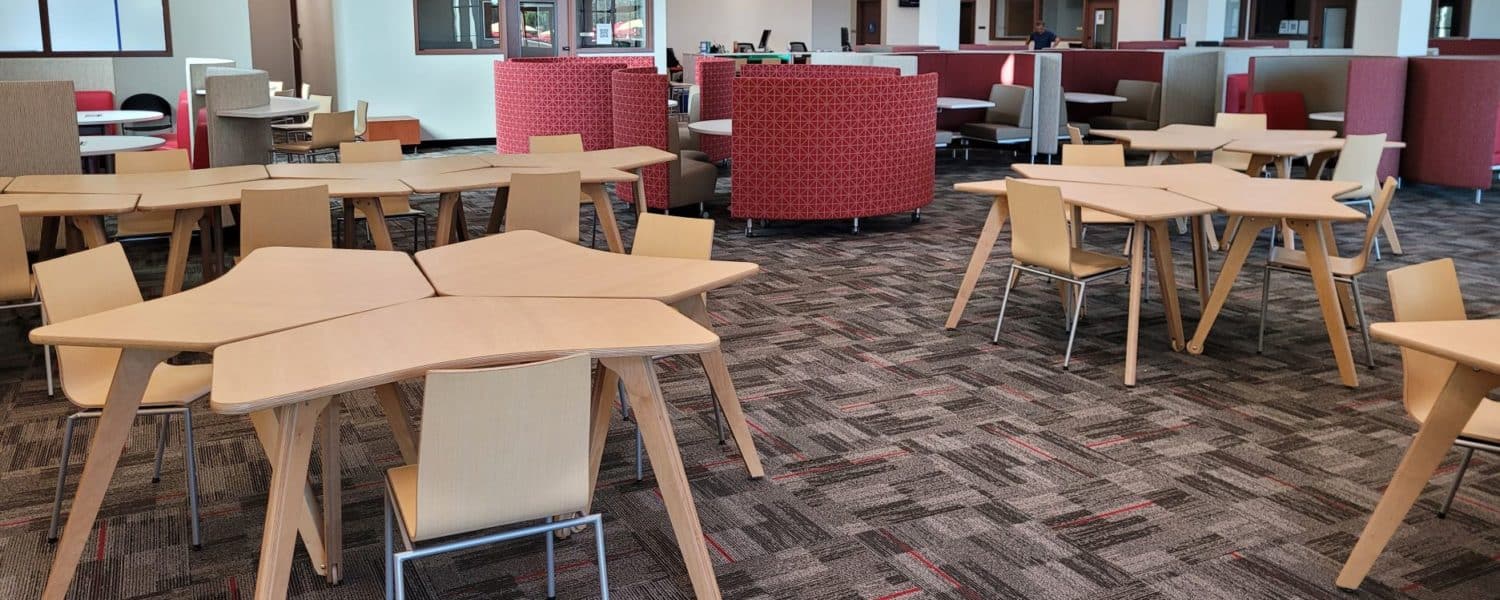By Joe S. Agati
Designing a library for students is no simple task. Whether you’re just updating furniture or doing a full redesign, here are five questions that will help you clarify the direction for your unique space.
- Who are you designing your space for?
Students, yes. But let’s go deeper than that. What do you know about the students who utilize your specific library throughout the week? Who are they? What do they need to accomplish? Why are they there?
While these may not be the first questions on your mind in the furniture decision-making process, these answers unlock the door to a design with real purpose — one where everyone who walks through your library doors can utilize the space meaningfully.
You aren’t just making decisions about the chairs, tables, desks, and shelves that will shape your space. You’re studying the motivations, the desires, and the behaviors of the students who fill it. In other words, your space should be designed to solve actual problems, rather than addressing perceptions you may have about how the space should be used.
Who will your space be designed for?
- How can you block out distractions?
We live in a busy world. No matter where we turn, the noise of sensory overload can feel overwhelming.
The right furniture design holds the key to turning the volume down. The chairs and couches we sit in, the desks and media centers that support big projects, the shelves and stands that hold our books and artwork—these are not simply about looks. These pieces of furniture play pivotal roles in masking the outside interferences that impede creative processes. They support our senses, acting as a doorkeeper to ensure comfort and calm.
Will you create distractions in your space? Or will you help block them out?
- How can you future-proof your space?
Especially in a school environment, you want to be prepared for the future. Not only do you want to support the goals of each of your students, but at a practical level, you want to make sure that the furniture you purchase now can be used for years to come. So, there are two things to consider:
Durability: School library furniture experiences a large amount of use (and abuse). For this reason, it has to be specifically designed to support the day-to-day use of your students. This is why your furniture is worth the investment; your typical office furniture won’t be able to support the daily use that your furniture will require.
Design: In the same way, the design and aesthetic of your facility needs to be as durable as the furniture within it. A well-designed space helps create an environment that feels welcoming, promotes connection when necessary, and supports focus.
How do you plan to combine durability and design to ensure your space is future-proof?
- How will human behavior influence your furniture selection?
It’s pretty common to consider furniture for its intended purpose (where it will be located, what it should be used for, etc.). But what if we instead understood how the people in our space will be moving, learning, and interacting, and then selected furniture designs that optimize those behaviors? Here are a few important needs to consider:
Personal Bubble: Typically, in public environments (and yes, a school counts as a public environment), personal bubble needs are a minimum of 12 inches. As others encroach upon this 12-inch bubble, people often become stressed.
Safe Haven: People have an inherent desire to feel safe and secure. One simple way to provide a feeling of “haven” is to make sure students’ backs are covered.
Comfort: When somebody sits in a seat that’s designed for a given task, it’s easy to see their comfort level is greater than it would be in a seat not intended for that use.
When letting human behaviors influence furniture selection, the odds of selecting the right pieces greatly increase, which results in happier students (to say nothing of saving costs on unforeseen renovations/purchases).
- How will you engage your stakeholders?
Whether you’re trying to find funding or to build buy-in around the updates in your space, there truthfully is no one-size-fits-all solution to ensure engagement. However, the support of your influencers and stakeholders is crucial. After over 30 years, here are a few things we’ve learned that help create support and engage your influencers:
Lean on your furniture vendors. Good furniture dealers and manufacturers should be able to provide high quality renderings of your space. This can help your stakeholders visualize the end product and create more excitement about the outcome.
Channel your inner salesperson. Interest isn’t built on its own. It’s crucial that you get out there and promote, promote, and promote some more. Share the vision. Send updates. Meet with current and potential stakeholders. Help people grasp the value and the opportunity.
Be able to present the value proposition. Especially for private schools, your facility is already such a crucial part of your recruitment and retention, alongside the need for effectively engaging your community. It’s important to understand the value proposition (ROI) of a project and be able to communicate how it will positively impact your school environment.
Do you have a plan to communicate why this project is worth supporting?
Your library environment matters deeply when it comes to accomplishing your mission for your students, and I hope these questions help you think through the design of your space in a new way.
Joe S. Agati is design director and chief operating officer for Agati Furniture, which designs durable library furniture that seamlessly blends form and function, www.agati.com.









